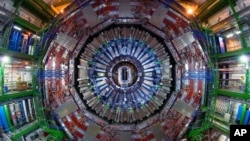Scientists at Europe's particle physics research center CERN on Sunday restarted their “Big Bang” Large Hadron Collider (LHC), embarking on a new bid to resolve some mysteries of the universe and look for “dark matter.”
The machine had been shut for two years for a refit. Hopes for the second run lie in breaking out of what is known as the Standard Model of how the universe works at the level of elementary particles, and into “New Physics.”
That includes searching for the dark matter that makes up about 96 percent of the stuff of the universe but can only be detected by its influence on visible matter like galaxies and planets.
Scientists are preparing for particle-smashing collisions expected to start in June, though any new discoveries made are unlikely to emerge until mid-2016.
The overhaul included new magnets, much higher energy beams and voltages and a complete check of all wiring around the underground 27-kilometer (17-mile) LHC tunnel and its four major detectors and multiple magnets.
“It's fantastic to see it going so well after two years and such a major overhaul,” CERN Director General Rolf Heuer said on the research organization's live blog for the restart.
During the last run, from 2010 to 2013, physicists tracked down the legendary Higgs boson particle after years of searching in the recorded debris from particle collisions at CERN and in other smaller colliders.
In two months, CERN will start smashing particles into each other in the LHC with nearly twice the energy compared with that first run from 2010-2013, and as before at close to the speed of light.
